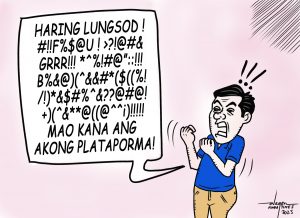Mindanao Development Authority (MinDA) Chair Leo Tereso A. Magno confirmed to me recently that the Mindanao Railway Project (MRP) is back on track.
Being “back on track” is not only an apt term for a railway project (train track), it also means “returning to the right path after a failure or mistake.”
First, full disclosure. I served as Deputy Project Manager of the MRP from November 2017 to October 2018. I was persuaded by then Department of Transportation (DoTr) Undersecretary for Railways Cesar Chavez, who is a personal friend, to help him with stakeholders’ engagement, especially with the local government units (LGUs) in the Davao Region.
I agreed only to serve as his consultant, but just a few days after I signed the contract, Cesar resigned from DoTr. Before I could ask him what happened, I got a memo from then DoTr Secretary Art Tugade designating me as Deputy Project Manager and tasked me to set up the Project Management Office (PMO) in Davao City.
Yes, one can say that I was “railroaded” into the whole thing. But I did what I could and did it for the love of Davao and Mindanao. Sadly, it was not a smooth ride and I had to get off before power-trippers from “imperial Manila” could push me under the (still nonexistent) train.
There must be so much money to be made on a train project for people to be shoving each other to get a piece of it. However, if that were true, why does it take forever for Mindanao to get its own railway system?
My brief experience trying to manage the project (it is hard to manage when you cannot make the decisions) gave me some insights.
One, the feasibility study, on which the plan of the MRP was based, is old. And it did not include cargo, just passengers. So in terms of serious return on investment, the cost of building the railway will be more than the projected revenue based on passenger volume alone. In 2018, project consultants were already pegging the cost at P2 billion per kilometer to build a railway.
The Mindanao Business Council (MBC) has pushed for a new study that will reflect cargo volume and insisted that train stations be connected to seaports and airports.
And this brings me to insight two – train station identification. We are not sure how the actual train stations were decided because one of them was right smack on a ravine. Some suspected they just used Google Earth to plot the stations because they were mostly in the middle of nowhere. Unless, of course, they were following the “Field of Dreams” philosophy of “if you build it, they will come.”
When they proposed the stations, there were no developments existing in the surrounding areas. By the time of project implementation, most of the areas were already fully developed with housing subdivisions, golf courses, and schools. That’s how long ago that study was made.
There was also little to no coordination done at the local level in deciding the alignment and the stations because almost all of the local decision-makers were baffled at the choices made by the national transport agency. Some LGUs are already even implementing their Integrated Transport Plan for their buses and other local public transport and the proposed train stations are nowhere near their transport hubs. Other localities also want the train station to be within their economic zones. These concerns alone should have prompted DoTr to pause and make a new study at that time.
Three, the approved MRP Phase 1 – the 102-kilometer Tagum-Davao-Digos (TDD) phase that was projected to have been completed by 2021 – was single-track, diesel-powered. This was rejected by the Regional Development Council (RDC) of Davao Region because it insisted that if Mindanao was to have its first railway, it better be dual track and electrified like the projects Mindanao taxpayers have been subsidizing in Metro Manila and Luzon.
To be fair, DoTr Secretary Tugade was very responsive and assured the Davao Region RDC that it would change the project design to reflect what the locals need and want. As far as I know, that is still being considered for “further study.”
Four, since the old study and plan proposed single-track, diesel-powered, there was no provision for electric supply. For the TDD phase, there are three power distributors, namely: Davao Light and Power Corp. (DLPC) for Davao City; Davao del Norte Electric Cooperative (DANECO) for Panabo, Carmen, and Tagum; and Davao del Sur Electric Cooperative (DASURECO) for Santa Cruz and Digos. We started the consultations on where to get the electricity to run the train but we were not able to resolve it in 2018.
If we could not resolve the issue of electric power supply for the TDD phase, I think it would even be more difficult to implement an electrified railway for the whole of Mindanao with many different electric cooperatives supplying every locality. This is a major issue that should be considered in the new feasibility study for MRP.
Five, despite all these unresolved issues locally, the national government still proceeded with the land acquisition of the right of way (ROW). DoTr felt pressured to do so because the budget was already there and they needed to spend the money. The LGUs concerned probably had little choice on the matter since it is a national project. This has been a perennial problem in implementing national projects in this country where the local communities are just expected to accept and be grateful for whatever is given.
Davao City, I am proud to say, stood its ground and did not fully cooperate in implementing the plan it did not completely agree with.
This was confirmed by the current DoTr Undersecretary for Railways Jeremy S. Regino in his letter to MinDA Chair Magno dated June 24, 2024: “ At present, the acquisition of the right of way is progressing in all designated areas, except for Davao City and Panabo, where funding constraints are being encountered.”
While it is also true that the project has run out of funds, there are more issues in Davao City in terms of alignment (physical, processes, and policies) that need to be resolved before land acquisition for right of way can happen.
In the same letter to Magno, DoTr also assured that “the feasibility study for the Mindanao Railway Project is currently being updated” that “may include potential integration of a freight line to maximize the project’s overall benefits.”
I am not sure what “currently being updated” means. I hope it means they will start a new one that reflects the new conditions on the ground. And I also hope they will engage the local stakeholders from the beginning and take the LGUs seriously and not just railroad them into submission to accept what is convenient and beneficial for the national government.
I was glad when MinDA Chair Magno told the media and the RDC representatives who are part of the MinDA Board that under his leadership, the LGUs and their local communities will be included in the decision-making process. “It will be an inclusive MinDA that will make sure that all the voices from Mindanao will be heard and listened to by the national government,” he said.
Because until the people of Mindanao are actively involved in planning, implementing, and managing their own railway system, any kind of Mindanao Railway Project will never be on the right track.


